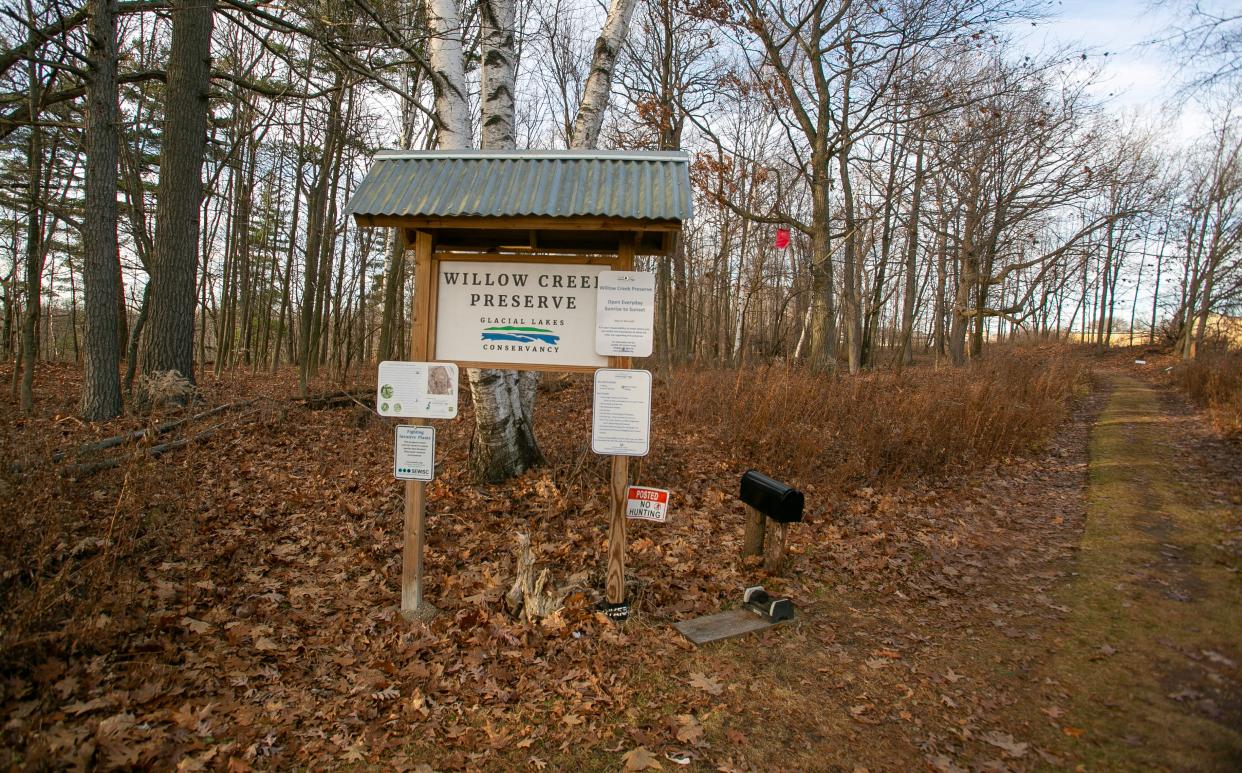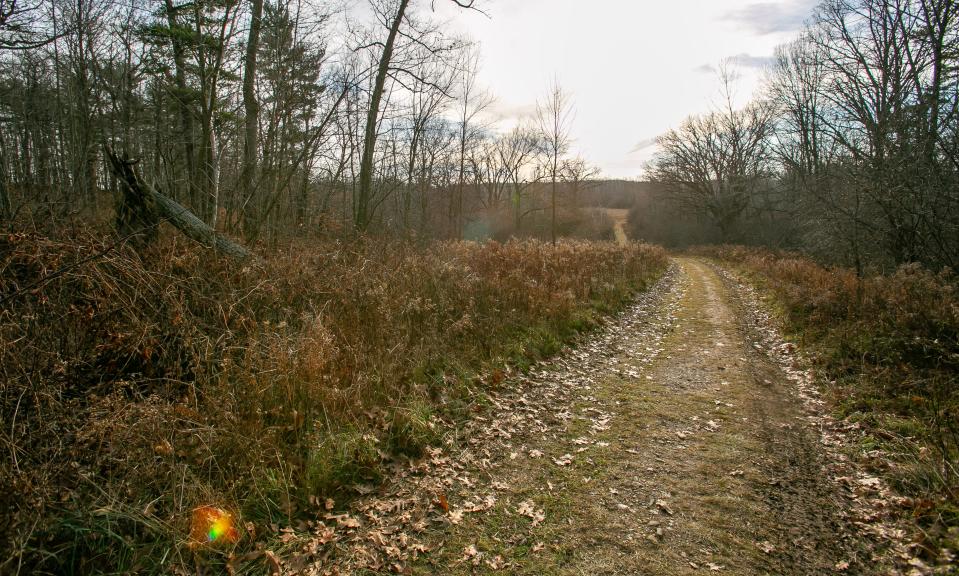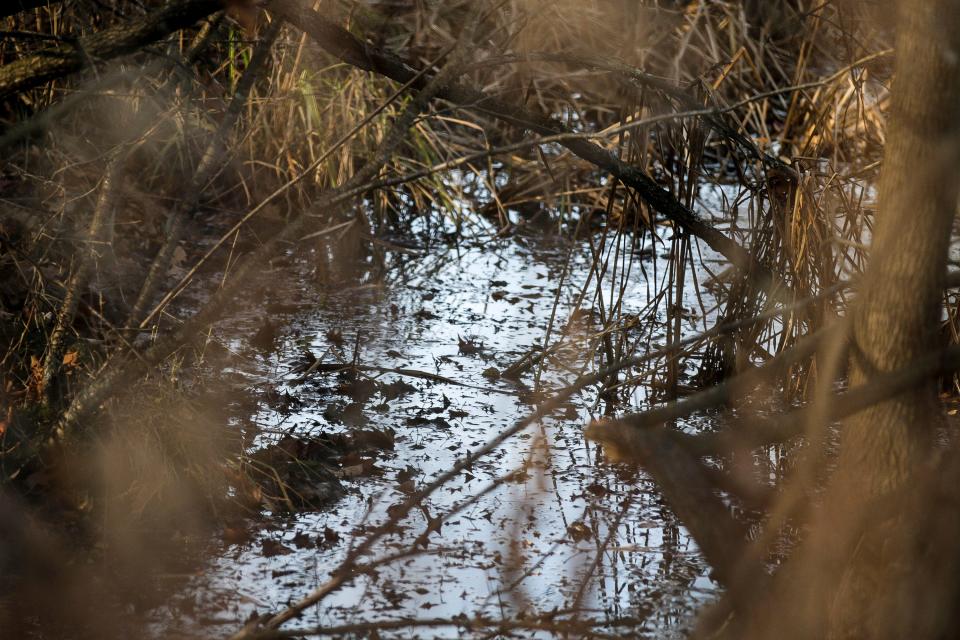How a local nonprofit is restoring Willow Creek with a $280K grant and water quality testing

SHEBOYGAN — A local land conservation nonprofit is working to protect a natural preserve off Taylor Drive.
Glacial Lakes Conservancy is pursuing a stormwater project and water quality testing to restore Willow Creek Preserve, a 143-acre preserve that is vulnerable to nearby runoff.
GLC acquired the undeveloped land in 2018, nestled between Indiana and Erie avenues. Visitors can hike, fish, snowshoe and bird watch on the preserve. Dogs are allowed but must be kept on a leash.
As the last natural landscape in the area and a tributary to the Sheboygan River, Willow Creek’s waterways are susceptible to urban runoff from nearby businesses, strip malls and residential communities.
Glacial Lakes Conservancy awarded $280,000 grant for stormwater system
GLC was awarded a roughly $280,000 grant from Sustain Our Great Lakes funding, in partnership with the U.S. Fish and Wildlife Service and the National Fish and Wildlife Foundation, for the development and installation of a Regenerative Stormwater Conveyance System. The organization also received support from Fund for Lake Michigan and the Wisconsin Department of Administration.
The roughly $500,000 RSCS project will be at one of four outfalls at the preserve referred to as the “Grand Canyon” among GLC staff because the hillside is so massively eroded, according to Isabel Mueller, Willow Creek project manager and land project coordinator.
The first outfall along the trail has the most alarming effect from runoff because nutrient- and sentiment-rich water from developed areas flows downstream through it, Mueller said. This has led to high levels of invasive species and degraded water quality.
New design could control water flow, filtration

RSCS projects — a series of shallow pools stocked with raw materials like native vegetation, rocks and wood chips — help mitigate storm water quality and some invasive species by filtering and slowing down the flow of water. It’s also a greener design, mimicking the natural pattern of water.
"What's coming into the preserve is not what's coming out,” Mueller said about implementing an RSCS. “We're doing our due diligence to protect the water that's on our site, but also the water that flows off of our site and making sure that we're not adding more to the area of concern that is the Sheboygan River.”
The lower 14 miles of the Sheboygan River in the Sheboygan area were designated as an Area of Concern under the 1987 Great Lakes Water Quality Agreement as a result of industrial plant contaminants.
The river has undergone significant remediation in years since, with Wisconsin Department of Natural Resources and U.S. Environmental Protection Agency support, to filter river sediments, restore native plants and revitalize wildlife habitats. The 14-mile area is still designated as an AOC.
City joins water contaminant case: Sheboygan Common Council approves joining multi-district PFAS settlement
RSCS projects have been done in southeast Wisconsin
A regenerative conveyance is a relatively new design for stormwater management, so there is a smaller body of research. Other stormwater management designs include constructed wetlands, retention ponds and permeable pavement.
RSCS projects have been implemented elsewhere in the state, in Milwaukee along the Kinnickinnic River at Pulaski Park and in Kenosha along the Root Pike watershed.
“It's actually very rare that they're done in situations such as ours,” Mueller said. “Typically, it'll be in the early stages of degradation from storm water, so you're not dealing with as massive of canyons.
“Our project will be very unique in the sense that it's been a problem for a while, and it needs to be fixed. It'll create a massive change, whereas the ones that have been installed are typically more of a preventative/minor improvement of the site,” she continued.
Stormwater project is still in early phases
The RSCS project is in its early stages still. Following preliminary designs in 2018 and 2019, GLC is now requesting proposals for final designs. The Willow Creek Preserve area will also undergo an archeological survey with University of Wisconsin-Milwaukee, which could begin this winter, weather permitting.
GLC Executive Director Jennifer Rutten said the study will be a learning opportunity for the community, a reminder about the Native Americans who formerly lived on the land.
Pursuing an RSCS among other restoration efforts will help protect Willow Creek, a “gem in the city limits,” Rutten said.
“It’s not a park, it's not a nature center,” she said. “It's very relaxed and the trails are relaxed, and people just get to take in the real habitat and wildlife there and the diversity.”
What is found in the survey will better determine the timeline of the RSCS project. Mueller said the project has been in discussions for the last few years, as the damage has compounded.
“We want to be a role model in the city and set an example of like, ‘Hey, here's what we can do to fix these problems that we're seeing,’” she said.
Cedar Grove pursues business park: The 152-acre Cedar Grove Business Park could increase industrial footprint along I-43 corridor
Data collection began last winter to develop baseline of water quality
GLC is also collecting water quality data at Willow Creek to better understand waterway conditions and create a baseline before RSCS implementation.
Mueller started chloride testing last winter in partnership with UW-Oshkosh, atypical from the May-October monitoring period, and said there was still a lot of water coming through.

“The chloride levels were higher than we would love to see on a preserve but also within an expected range due to where the water is coming from on those roadways nearby,” she said. “Ideally, we'd love to see people putting down less salts and using different solutions, so that we could lower that, especially as we implement projects like the RSCS.”
Monitoring continued through the spring and summer with Water Action Volunteers, an initiative through the DNR and UW-Madison, tracking data for total phosphorous and suspended solids, according to Muller. GLC also monitored water conditions, like dissolved oxygen, temperature and stream flow.
Water testing could expand to other GLC properties
The organization hopes to continue water quality testing next year, with more efficient equipment and streamlined techniques. GLC could possibly expand testing on other properties, like Hunner Preserve and Charles & Winifred Spring West Twin River Preserve in Kewaunee and Manitowoc counties, respectively.
“Though we have so much work to do, it is a really, really diverse habitat,” Mueller said about Willow Creek. “It has everything from wetlands to ponds to flowing water to forested ecosystems.
She continued, “It’s a really huge, huge resource, whether or not people know about it and hike there.”
Contact Alex Garner at 224-374-2332 or agarner@gannett.com. Follow her on X (formerly Twitter) at @alexx_garner.
This article originally appeared on Sheboygan Press: Willow Creek restoration in Sheboygan continues with help of grant

